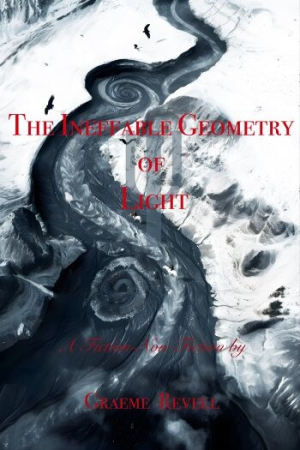
The Ineffable Geometry of Light
The Ineffable Geometry of Light is a lavish and inquisitive novel whose heroes reveal the curiosity and vulnerability of all sentient beings.
Motivated by personal trauma and a yearning to answer some of the most profound questions ever explored in science and philosophy, three people traverse personal struggles and the wilderness of New Zealand in Graeme Revell’s literary novel The Ineffable Geometry of Light.
Half of the novel takes place in the near future, the other half in the 1800s. At the start of the story, with advanced scientific gadgets in tow, James, a grieving professor, decides to trek through New Zealand with a mysterious genius, Madeleine, whom he meets in a cafe at the start of his travels. James seeks to process a recent, unimaginable loss by experiencing the physical discomforts of hiking. Madeleine strives to understand her purpose and find meaning in who she is before she is tracked down by the scientists she escaped from.
Together, the seekers bond over intellectual subjects, covered in pages of lavish conversation. Discussing the origins of words and the beauty of poetry helps them realize they both have a vast capacity to understand each other’s complex minds and secrets. These connections encourage them to partner in their travels, first on foot, then on horseback, to some of the most unreachable areas of New Zealand.
James and Madeleine’s philosophical discussions, which are braided with detailed descriptions of their struggles in the wilderness as they hike from one shelter to another, become a dance of sorts. Each intellectual roadblock coincides with a test of survival and interpersonal relationships. They face intense storms, freezing weather, injuries, and sudden drone attacks, which bind them together just as much as their ideas about science, poetry, etymology, and religion do.
These philosophical musings also appear in the historical storyline, which focuses on Samuel Butler, the novelist, critic, and adventurer. These chapters also begin with a treacherous journey, as Butler hopes to discover a passage across New Zealand. He also experiences his own exploration of the intellect as he questions the nature of the universe and existence. After establishing his sheep business, he purchases a copy of Charles Darwin’s On the Origin of Species and becomes a dedicated fan of Darwin’s work, but this controversial interest increases the isolation he feels among his peers.
Throughout Samuel’s chapters, themes of curiosity and loneliness play out. For example, he rarely has the companionship, romantic or intellectual, that he desires. The small amount of popularity he achieves by playing the piano for local parties is overshadowed by his notorious articles about evolution and science that he publishes in the local Christchurch newspaper.
The conversations of all three characters and their interior thoughts create the complex backdrop for the book’s overriding philosophical questions. James, Madeleine, and Samuel demonstrate the richness of scientific inquiry and how subjects intersect, just as the journeys they take culminate in a meaningful crescendo.
The Ineffable Geometry of Light surprises throughout with unexpected scenes of violence and sexual intimacy. However, the novel is at its strongest when focused on the complex, interior musings of its characters, especially Madeleine. In this literary powerhouse, there are eventual, unexpected intersections between Samuel’s life and James’s and Madeleine’s lives, demanding renewed respect for the curiosity and vulnerability that all sentient beings experience.
Reviewed by
Clarissa Adkins
Disclosure: This article is not an endorsement, but a review. The publisher of this book provided free copies of the book and paid a small fee to have their book reviewed by a professional reviewer. Foreword Reviews and Clarion Reviews make no guarantee that the publisher will receive a positive review. Foreword Magazine, Inc. is disclosing this in accordance with the Federal Trade Commission’s 16 CFR, Part 255.
